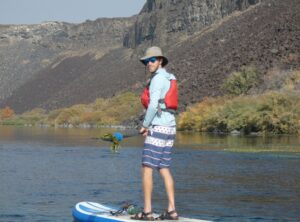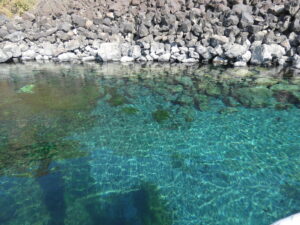Tucked in a bend of Idaho’s mighty Snake River, crystal clear spring water bubbles up from below, creating a sapphire oasis in the desert canyon. On Oct. 16, ICL staff set out to find this unique spot, about halfway between Hagerman and Buhl, called Blue Heart Springs. While Blue Heart Springs is a natural gem in the Snake River landscape, our journey there and back was an opportunity to reflect on the severe water quality issues facing the Snake River and why we must work together to solve them.
The Snake River is largely seen as a “working river.” It provides irrigation water to agricultural operations across southern Idaho and clean water to local producers that raise fish, such as trout and sturgeon. Indeed, the Snake River and its aquifer are what makes the Magic Valley magic — by watering Idaho’s agricultural heartland. But, agricultural runoff and discharge from fish production plants flow back into the Snake River, carrying excess fertilizers and other pollutants into the river. These pollutants contaminating the Snake River threaten all who depend on its water.
But the Snake River is much more than a working river. It’s aquifer, the Eastern Snake River Plain Aquifer, provides drinking water for 300,000 Idahoans. And the Snake River and the deep basaltic canyon it carves provide a wealth of outdoor adventures, inspiring vistas, and opportunities for family fun.
Discovering Blue Heart Springs
Taking COVID-19 precautions, I met ICL’s Josh Johnson and Jonathan Oppenheimer at Banbury Hotsprings. We launched from the boat ramp into the main channel of the Snake River, each of us on our own standup paddleboard. We paddled downstream, floating easily along in the calm waters under the bright fall sunshine. We noticed murky water and lots of macrophytes, or nuisance aquatic vegetation, growing in the river. The macrophytes caught the fins of our paddleboards and silently trailed behind us as we headed downstream.
 Unlike the Wild and Scenic Rivers that flow through Idaho’s wildest places, industrial activities are easy to see all along the Snake River. We passed several fish farms on the south side of the river, as well as numerous pipes channeling water back into the Snake from towns and farms across the Magic Valley. Despite all this activity and development, the Snake River Canyon towered above us, providing habitat for birds of prey and other riverside creatures.
Unlike the Wild and Scenic Rivers that flow through Idaho’s wildest places, industrial activities are easy to see all along the Snake River. We passed several fish farms on the south side of the river, as well as numerous pipes channeling water back into the Snake from towns and farms across the Magic Valley. Despite all this activity and development, the Snake River Canyon towered above us, providing habitat for birds of prey and other riverside creatures.
As we approached a stunning side notch in the canyon, the water we were paddling through became clearer and clearer. The outflow from Box Canyon Springs burst from the north side of the river, tumbling into the Snake. We caught a glimpse of giant carp swimming below us among a large growth of aquatic vegetation. A stark line separated the clear spring water from Box Canyon flowing into the river and the cloudy main channel of the Snake with its thick beds of nuisance vegetation.
 Another quarter-mile downstream, we reached a sharp bend in the river. Hidden behind bushes that line the river, we spied a gap and found Blue Heart Springs, a wondrously clear pocket of spring water. We floated on the water for about an hour, taking in the high canyon walls above us and the shimmering water below. . We were mesmerized by the bubbling sands at the bottom, where the spring water rose from underground. Little fish flitted across the floor, while bigger fish swam in and out of the shadows in the deeper parts of the pool.
Another quarter-mile downstream, we reached a sharp bend in the river. Hidden behind bushes that line the river, we spied a gap and found Blue Heart Springs, a wondrously clear pocket of spring water. We floated on the water for about an hour, taking in the high canyon walls above us and the shimmering water below. . We were mesmerized by the bubbling sands at the bottom, where the spring water rose from underground. Little fish flitted across the floor, while bigger fish swam in and out of the shadows in the deeper parts of the pool.
After lunch and a few casts of the fly rod with no bites, we headed back upstream. Though the current is slow on this section of river, it was still hard work paddling back to the Banbury boat launch.
Restoring Idaho’s Snake River
Our adventure to Blue Heart Springs opened our eyes to how rewarding it is to explore the Snake River canyon. The river boasts incredible recreational opportunities in a landscape that combines desert canyons with clear crystal springs.
But to ensure that the Snake River is a safe place to swim, fish and recreate, the river requires a bold effort to address the worsening problems from agricultural pollution, chiefly from phosphorus and nitrate. Rising concentrations of these pollutants in the Snake River region continue to have serious implications for public health and the state’s ability to meet its water quality standards.
In some parts of the Snake River, it is not safe to swim in the waters, eat fish caught in the river, or even let your pets touch the water. Paddling through the mid-Snake region, we saw first hand the factors that indicate poor water quality in the Snake River, including nuisance aquatic vegetation.
Declining water quality affects everyone who relies on the Snake River and we all share a responsibility to address the issue. ICL was founded to be a strong voice for clean water. Our long-term goal is to make the Snake River across southern Idaho safe, fishable and swimmable again. To do so will likely require a large state-federal cleanup plan akin to restoration efforts in the Great Lakes and Chesapeake Bay. Special places like Blue Heart Springs inspire and drive our work toward a clean and safe Snake River for Idaho’s future.
For directions to Blue Heart Springs and to read about other ICL Adventures: Plan Your Own Adventure
Share your Snake River adventures with us!
Help us restore the Snake River today by sharing your adventures and experiences on and around the Snake and why the river matters to you.
Join us November 17 at 5:30 MT for a webinar on envisioning a clean future for the Snake River
Join us for a webinar where you’ll learn about our vision for a clean and safe Snake River. You’ll hear from ICL’s Conservation Associate Josh Johnson about the declining water quality in the Snake River and aquifer and the path forward for cleaning up the Snake. Register today!

